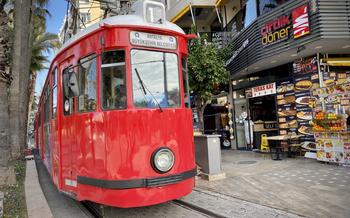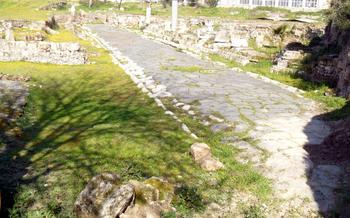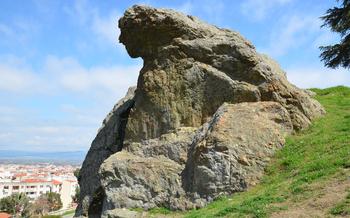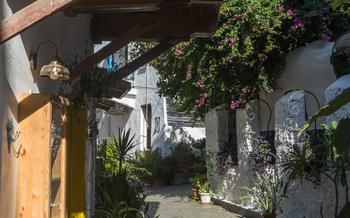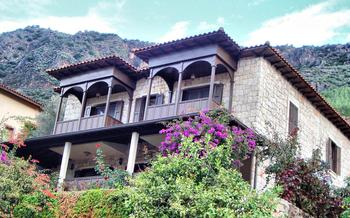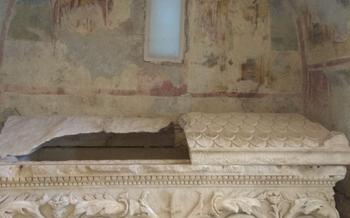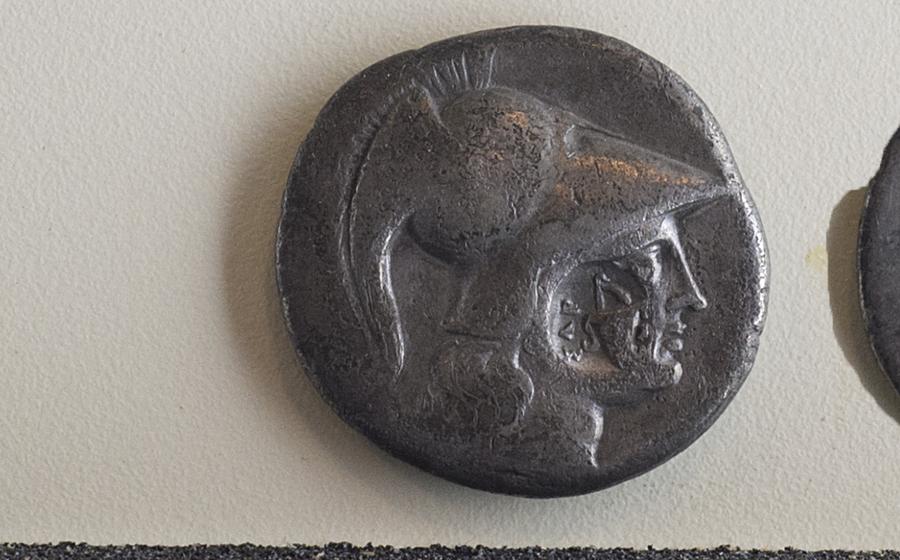
Side Museum
- Side Museum: A Journey Through Antiquity
- The Ancient City of Side: A Journey into the Past
- The Side Theater
- The Temple of Apollo
- The Agora and Colonnaded Street
- The Side Harbor
- The Side Archaeological Museum
- The Side Necropolis
- The Side Walls and Gates
- The Side Aqueduct: An Engineering Marvel
- The Side Basilica
- The Side Museum Garden: A Place of Beauty and Learning
- The Side Festival
- Side Cuisine
- Insider Tip: Hidden Gems of Side
Side Museum: A Journey Through Antiquity
The Side Museum, nestled in the heart of the ancient city of Side, stands as a testament to the region's rich history and cultural heritage. Established in 1948, the museum houses an extensive collection of artifacts unearthed from the ancient city and its surroundings, offering visitors a glimpse into the past. Its significance lies in preserving and showcasing the cultural wealth of Side, a city once known for its strategic location, vibrant trade, and architectural marvels. Located within the Side Archaeological Park, the museum is easily accessible, inviting visitors to embark on a journey through the annals of time.
Highlights of the Museum's Collection
Among the museum's treasures, visitors can marvel at intricate sculptures that depict gods and goddesses, capturing the essence of ancient mythology. Mosaic floors, meticulously crafted with vibrant colors and detailed patterns, offer a glimpse into the artistic prowess of Side's artisans. A collection of coins, pottery, and jewelry provides insights into the city's economic activities and daily life. The museum's collection not only tells the story of Side's past but also offers a fascinating glimpse into the lives of its inhabitants, their beliefs, and their contributions to the region's cultural tapestry.
Practical Information
The Side Museum is open to the public from 8:00 am to 5:00 pm daily, except for Mondays, when it remains closed. Admission fees are minimal, ensuring accessibility for visitors from all walks of life. Guided tours are available in various languages, providing in-depth insights into the museum's exhibits and the history of Side. The museum's knowledgeable staff is always ready to assist visitors, answering questions and ensuring a memorable experience.
The Ancient City of Side: A Journey into the Past
For history enthusiasts and lovers of ancient civilizations, Side is a treasure trove of wonders. Step back in time as we explore the ancient city, where the ruins of the past paint a vivid picture of a once-thriving metropolis.
Side, with its strategic location on the Mediterranean coast, was a prominent city in antiquity. Founded in the 7th century BC by Greek settlers, it quickly became a hub of trade and commerce. The city's prosperity and significance are evident in the impressive remains that stand today.
Within the ancient city, visitors can marvel at the well-preserved ruins of the Agora, the bustling marketplace where merchants and shoppers once haggled over goods from distant lands. The Colonnaded Street, lined with shops and adorned with intricate columns, leads to the Temple of Apollo, a majestic structure dedicated to the Greek god of the sun.
The Side Theater, with its impressive stage and seating capacity of over 15,000 spectators, hosted theatrical performances, concerts, and gladiatorial contests. The Side Museum houses a rich collection of artifacts that provide a glimpse into the city's glorious past, including sculptures, mosaics, and everyday objects.
Whether you're a history buff, an archaeology enthusiast, or simply someone who loves to explore ancient ruins, the ancient city of Side is a must-visit destination.
Insider tip: For the best experience, visit the ancient city early in the morning or late in the afternoon to avoid the midday heat. Wear comfortable shoes and bring plenty of water, as the site is extensive and there is limited shade.
The Side Theater
The Side Theater is an iconic landmark within the ancient city of Side, a testament to the city's cultural and artistic heritage. Constructed in the 2nd century AD, this impressive structure could accommodate up to 15,000 spectators, making it one of the largest theaters in the Roman province of Pamphylia.
With its well-preserved stage and orchestra, the theater served as a venue for a variety of performances, including plays, concerts, and gladiator fights. The stage is adorned with intricate carvings depicting scenes from Greek mythology, while the acoustics are remarkable, allowing performers' voices to carry throughout the entire auditorium.
In ancient times, the theater played a crucial role in the social and cultural life of Side. It was a place where citizens gathered to be entertained, express their artistic talents, and celebrate important events. Today, the theater continues to host cultural events, concerts, and performances, providing visitors with a glimpse into the city's rich past.
Insider tip: Attending a performance at the Side Theater is an unforgettable experience. Check the local event calendar for upcoming shows and immerse yourself in the magic of this ancient venue.
The Temple of Apollo
The Temple of Apollo, one of the most iconic landmarks of ancient Side, stands as a testament to the city's rich cultural heritage and devotion to the Greek gods. Built in the 2nd century AD, this grand temple was dedicated to Apollo, the god of music, poetry, and prophecy.
Its imposing facade, adorned with intricate carvings and sculptures, hints at the grandeur that once defined this sacred site. The temple's architectural features, such as the iconic Corinthian columns and the pediment depicting scenes from Greek mythology, showcase the exceptional craftsmanship of its builders.
The Temple of Apollo holds a significant place among the other temples in the region. It served as a prominent center for religious ceremonies, festivals, and oracles, attracting pilgrims and worshippers from far and wide. Its close proximity to the harbor allowed sailors and merchants to seek divine guidance and protection before embarking on their seafaring journeys.
Insider tip: To capture the temple's ethereal beauty, visit during sunset. As the golden rays illuminate the temple's facade, the intricate details and carvings come alive, creating a magical and awe-inspiring sight.
The Agora and Colonnaded Street
The agora, or marketplace, was the heart of ancient Side, a bustling center of commerce and social interaction. Excavations have revealed the remains of shops, warehouses, and public buildings, providing a glimpse into the city's vibrant commercial life. The agora was surrounded by a colonnaded street, a covered walkway lined with shops and offering shelter from the sun and rain. This elegant street was a popular gathering place for locals and visitors alike, where they could stroll, shop, and socialize.
The agora and colonnaded street are a testament to Side's importance as a trading hub in antiquity. The city's strategic location on the Mediterranean Sea made it a natural crossroads for merchants from across the region. The agora was the place where goods from all over the world were bought and sold, from spices and silks from the East to olive oil and wine from the local countryside.
Today, the agora and colonnaded street are a popular tourist attraction, offering visitors a glimpse into the daily life of an ancient city. The well-preserved ruins, including the remains of shops, warehouses, and public buildings, provide a fascinating insight into Side's commercial and social history. The agora is also home to a number of ongoing archaeological excavations, which are shedding new light on the city's past.
Insider tip: Take your time exploring the agora and colonnaded street, and be sure to visit the nearby shops and restaurants to soak up the atmosphere of this ancient marketplace.
The Side Harbor
The ancient harbor of Side, once a bustling hub of maritime trade and commerce, lies just a short walk from the city center. While much of the harbor has been lost to time and the relentless Mediterranean Sea, the remains of ancient harbor structures and fortifications still stand as a testament to Side's former maritime prowess.
These remnants of the past, including sturdy breakwaters and imposing towers, offer a glimpse into the city's strategic importance as a trading port. In antiquity, ships from across the Mediterranean Sea would dock at Side, bringing goods and exotic treasures from distant lands. The harbor was also a vital gateway for Side's exports, such as olive oil, wine, and textiles, which were shipped to far-off destinations.
Today, the picturesque harbor is a popular spot for visitors to stroll along the waterfront, admiring the ancient ruins and soaking up the tranquil atmosphere. Visitors can also take a boat tour from the harbor, offering a unique perspective of Side's coastline and the stunning turquoise waters of the Mediterranean Sea.
Insider tip: Embark on a sunset boat tour from the harbor to witness the magical play of colors as the sun dips below the horizon, casting a golden glow over the ancient city and the surrounding landscape.
The Side Archaeological Museum
The Side Archaeological Museum is a treasure trove of artifacts that narrate the captivating story of Side's glorious past. Established in 1948, the museum houses a remarkable collection of sculptures, mosaics, and artifacts that provide a glimpse into the city's rich history and cultural heritage.
Among the museum's highlights is the impressive collection of sculptures, which includes intricate marble statues of gods, goddesses, and prominent figures from Side's past. These sculptures offer a testament to the city's artistic prowess and the influence of Hellenistic and Roman art.
Equally captivating are the intricate mosaics that adorn the museum's floors and walls. These vibrant mosaics depict scenes from mythology, daily life, and religious rituals, offering a glimpse into the beliefs and practices of Side's ancient inhabitants.
The museum also houses a collection of artifacts that shed light on Side's economic and social life. These include coins, pottery, tools, and jewelry, providing insights into the city's trade, industry, and everyday life.
A visit to the Side Archaeological Museum is a journey through time, allowing visitors to connect with the ancient world and gain a deeper understanding of Side's rich history and cultural legacy. The museum's collection is a testament to the city's significance as a center of art, culture, and commerce in antiquity.
The Side Necropolis
A Journey into the Afterlife
The Side Necropolis, situated on the outskirts of the ancient city, offers a glimpse into the burial customs and beliefs of Side's inhabitants. Explore the various types of tombs, ranging from simple pit graves to elaborate family mausoleums, each reflecting the social status and wealth of the deceased. Discover the intriguing funerary rituals and practices that accompanied the transition from life to the afterlife.
Insider Tip: Visit at Dusk
For an atmospheric experience, visit the necropolis at dusk when the fading light casts an ethereal glow on the tombs and surrounding landscape. The tranquility of the evening provides an ideal setting for contemplating the lives and legacies of Side's ancient citizens.
The Side Walls and Gates
The ancient city of Side was once a fortified city, protected by a system of walls and gates. The walls were built in the 4th century BC and were constructed using large blocks of stone. They were approximately 8 kilometers long and reached a height of 12 meters in some places. The walls were reinforced by numerous towers and bastions, which provided additional protection against attack.
There were several gates that allowed access to the city. The main gate was the Land Gate, which was located on the north side of the city. Other gates included the Sea Gate, which was located on the south side of the city, and the East Gate, which was located on the east side of the city. The gates were heavily fortified and were guarded by soldiers.
The Side walls and gates are an important part of the city's history and heritage. They are a reminder of the city's military importance and its role as a major trading center. Today, the walls and gates are a popular tourist attraction and offer visitors a glimpse into the city's past.
Insider Tip:
Walk along the top of the walls for a stunning view of the city and the surrounding countryside. The walls are well-maintained and provide a safe and enjoyable way to explore the city's fortifications.
The Side Aqueduct: An Engineering Marvel
The Side Aqueduct stands as a testament to the ingenuity and engineering prowess of the ancient Sideans. Constructed in the 2nd century AD, this remarkable structure brought fresh water from the Taurus Mountains to the city, transforming daily life and economic activities.
Built using stone and brick, the aqueduct stretched for over 30 kilometers, traversing challenging terrain and spanning valleys and rivers. Its impressive height and sturdy construction allowed water to flow continuously, providing a reliable water source for Side's growing population.
More than just a functional structure, the Side Aqueduct was also an architectural marvel. Its towering arches and intricate design elements showcased the artistic talents of the builders. The aqueduct's presence not only served a practical purpose but also added to the grandeur and beauty of the ancient city.
Insider Tip: For a truly immersive experience, follow the route of the aqueduct, exploring its well-preserved sections and admiring the natural landscapes it traverses. This journey will provide a deeper appreciation for the engineering marvel that sustained ancient Side.
The Side Basilica
The Side Basilica is a magnificent testament to the city's Christian heritage, dating back to the 5th century AD. This grand structure boasts an impressive architectural design, featuring a spacious nave, intricate mosaics, and soaring columns. As you step inside, you'll be captivated by the basilica's serene atmosphere, which invites contemplation and reflection.
The basilica's well-preserved condition offers a glimpse into the grandeur of early Christian architecture. Admire the intricate mosaic floors that depict biblical scenes and religious symbols, a testament to the skill and artistry of Side's artisans. The basilica's apse, with its elevated altar and ornate decorations, adds to the sacred ambiance of the space.
This basilica holds a significant place in Side's history, serving as a gathering place for the city's Christian community. Imagine the vibrant atmosphere during religious ceremonies and festivals, with the basilica echoing with the sounds of prayers and hymns. Today, the basilica stands as a reminder of Side's rich religious heritage and continues to inspire visitors with its architectural splendor.
Insider tip: Enhance your visit by attending a religious service at the basilica. Immerse yourself in the local culture and witness the devotion of the Side community. This unique experience will provide a deeper understanding of the city's spiritual heritage.
The Side Museum Garden: A Place of Beauty and Learning
The Side Museum Garden is a hidden gem that complements the Side Museum's educational and cultural mission. Nestled amidst the ancient ruins, this serene space offers visitors a tranquil retreat where they can relax, reflect, and learn.
Established in the early 20th century, the garden has been meticulously designed to showcase a diverse collection of plants and flowers. Visitors can stroll along winding paths, admiring the vibrant colors and fragrant blooms of roses, bougainvillea, hibiscus, and oleander. The garden also features a variety of trees, providing shade and creating a sense of tranquility.
One of the highlights of the Side Museum Garden is its collection of ancient olive trees. These majestic trees, some of which are centuries old, symbolize the region's rich agricultural heritage. Visitors can learn about the history of olive cultivation in Side and sample the delicious local olive oil, which is produced using traditional methods.
The Side Museum Garden is not just a beautiful space; it also serves as an educational resource for visitors of all ages. The garden is home to a variety of educational programs and workshops, where visitors can learn about the region's flora and fauna, as well as its cultural and historical significance.
For those seeking a moment of peace and tranquility, the Side Museum Garden offers the perfect escape. Visitors can relax on a bench beneath a shady tree, read a book, or simply enjoy the beauty of their surroundings. The garden is a place where visitors can connect with nature, history, and culture, creating lasting memories of their time in Side.
The Side Festival
The Side Festival is an annual celebration that showcases the city's rich cultural heritage and vibrant traditions. Held during the summer months, the festival typically lasts for several days and features a variety of events, performances, and exhibitions that bring the city to life.
One of the highlights of the festival is the traditional Turkish music and dance performances. Visitors can enjoy mesmerizing shows that showcase the talents of local performers and immerse themselves in the infectious rhythms and melodies of Turkish music.
In addition to music and dance, the festival also features art exhibitions, historical reenactments, and culinary demonstrations. Visitors can admire the works of local artists, learn about Side's fascinating history through live performances, and savor the flavors of traditional Turkish cuisine.
The Side Festival is a wonderful opportunity to experience the city's cultural heritage firsthand and connect with its vibrant community. By attending the festival, visitors can gain a deeper understanding of Side's rich past and its continued significance as a cultural hub in the region.
Insider tip: Attend the festival in traditional Turkish attire to fully immerse yourself in the experience and show your respect for the local culture.
Side Cuisine
The cuisine of Side is a delectable blend of flavors, reflecting the city's rich history and diverse cultural influences. Over the centuries, Side has been a melting pot of civilizations, each leaving its mark on the local culinary traditions. From the ancient Greeks and Romans to the Byzantines, Seljuks, and Ottomans, each empire has contributed to the unique flavors of Side's cuisine.
Must-Try Dishes:
-
Manta: These delicious Turkish ravioli are filled with either meat or cheese and topped with a yogurt sauce, garlic, and red pepper flakes.
-
Köfte: These grilled meatballs are a staple of Turkish cuisine and are often served with rice, vegetables, or salad.
-
Mezze: A selection of small dishes, such as hummus, baba ghanoush, and stuffed grape leaves, is a great way to sample a variety of Side's culinary delights.
-
Pide: These Turkish flatbreads are topped with various ingredients, such as cheese, meat, or vegetables, and are a popular street food.
-
Baklava: This sweet pastry, made with layers of filo dough filled with nuts and honey, is a must-try for those with a sweet tooth.
Insider Tip:
- To experience the true essence of Side's cuisine, venture beyond the main tourist areas and explore the local markets and small family-run restaurants. These hidden gems often offer the most authentic and delicious dishes, prepared with fresh, local ingredients.
Insider Tip: Hidden Gems of Side
Beyond the well-known landmarks, Side offers a treasure trove of hidden gems waiting to be discovered. For those seeking a unique and off-the-beaten-path experience, here are some insider tips:
-
The Side Olive Oil Museum: Immerse yourself in the world of olive oil production at this fascinating museum. Learn about the history, techniques, and significance of olive oil in Turkish cuisine.
-
The Side Harbor Market: Experience the vibrant atmosphere of the local market, where you can browse fresh produce, traditional crafts, and souvenirs. Engage with friendly vendors and savor the authentic flavors of Side.
-
The Side Boat Tours: Embark on a scenic boat tour along the picturesque coastline. Discover hidden coves, secluded beaches, and stunning views of the Mediterranean Sea.
-
The Side Panoramic Viewpoint: Hike or drive to the panoramic viewpoint for breathtaking vistas of the ancient city, the harbor, and the surrounding landscapes. Capture unforgettable photos and memories.
-
The Side Sunset Spot: Find a secluded spot along the coast to witness the magical sunset over the Mediterranean Sea. Enjoy a romantic moment or simply soak in the tranquility of the surroundings.
